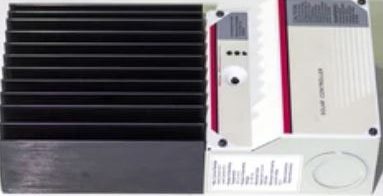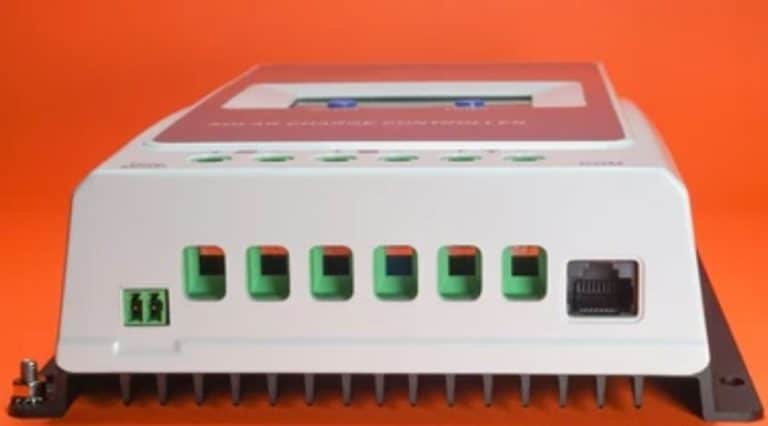Solar charge controller: A comprehensive guide and review
As the popularity of solar energy continues to rise, the need to understand the importance and functionality of a solar charge controller is essential.
For those interested in promoting sustainability and reducing their carbon footprint, investing in a solar power system with an efficient charge controller can be a significant step towards achieving these goals.
In this comprehensive guide, we will delve into various aspects related to solar charge controllers.
We will discuss different types of charge controllers along with factors that influence choosing the right one for your specific needs.
Finally, we will explore key features and functions offered by this device and some advanced monitoring capabilities.
In the end, you will be equipped with the information you need to invest in a top-notch solar charge controller.
So jump in let’s get started.
What is a solar charge controller?
A solar charge controller is simply a device that regulates your solar battery, preventing it from damage caused by overcharging, undercharging, and short-circuiting.
It is an essential component of any solar power system. It acts as the “brain” that controls the flow of electricity from your solar panels to your battery.
In simple terms, when sunlight hits the solar panels, they generate electricity in the form of direct current (DC).
This DC voltage needs to be regulated before it can be used by most appliances or stored in a battery for later use.
That’s where a solar charge controller comes into play. They take this raw energy generated by the panels and manage its distribution within your system.
The importance of solar charge controllers
- Battery protection: One of their main functions is protecting batteries from damage caused by overcharging or discharging too quickly. Over time, these issues can lead to reduced battery life and even complete failure.
- Efficient charging: A good quality charge controller will also help maximise charging efficiency. This is done by adjusting voltage levels based on factors such as temperature and state-of-charge (SOC) conditions.
- Safety features: Most controllers come with built-in safety features like short circuit protection. this does which help to prevent accidents due to wiring errors or faulty components within your system.
An essential component for off-grid systems
If you’re planning on setting up an off-grid solar power system – whether it’s for a remote cabin getaway or living entirely off-the-grid – having a reliable charge controller becomes even more critical.
Ensuring batteries are in top condition and operating properly is critical when relying on stored energy from them.
A key player in grid-tied systems
Even if you have a grid-tied solar power system where excess energy is fed back into the utility grid for credit or compensation, having a quality charge controller still plays an essential role.
In case of any issues with the main electrical grid or during periods of high demand when electricity prices surge, having stored backup power becomes invaluable – especially if you live in areas prone to natural disasters like hurricanes or wildfires that can cause extended outages.
By utilising a solar charge controller, you can maximise your return on investment. By so doing, you also ensur the safe operation of your systems.
A solar charge controller is a crucial component of any solar power system. It regulates the flow of electricity from panels to batteries while preventing damage caused by overcharging or discharging too quickly.
Types of solar charge controllers
There are two main types of solar charge controllers available in the market. These are Pulse Width Modulation (PWM) and Maximum Power Point Tracking (MPPT).
Both types offer distinct benefits and drawbacks, thus making them suitable for different needs and applications.
Pulse width modulation (PWM) charge controllers
These controllers step down the voltage level applied to it from your solar panel or solar array, keeping a steady amount of energy as the battery nears full capacity.
They tend to utilise a simple ‘rapid switch’ to to regulate the battery charging process.
Once the battery reaches the absorption charge voltage, the switch (transistor) begins to open and close rapidly at a frequency of hundreds of times per second.
This modulation of current helps to maintain a constant battery voltage.
The problem with this system of control that PMW causes the solar panel voltage to decrease in order to match the battery voltage.
This then results in a deviation from the panel’s optimal operating voltage (Vmp). Consequently, this leads to a reduction in the panel’s power output and operational efficiency.
PWM solar charge controllers are an affordable option for small 12V systems that require one or two solar panels.
Hence, they tend to work well for basic applications like camping, solar lighting and charging USB/phones.
But if more than one panel is required, they should be connected in parallel instead of series (unless the panels have a low voltage and the battery has a higher voltage).
- Advantages: PWM controllers are relatively less expensive, making them an attractive choice for smaller systems or those on a budget. They also tend to be simpler in design, which can result in increased reliability.
- Disadvantages: The primary drawback of PWM controllers is their lower efficiency. This means they may not extract as much energy from your solar panels as possible. This is especially when there’s a significant difference between panel voltage output and battery voltage input levels. In colder climates or during temperature fluctuations, PWM controllers can experience reduced efficiency levels due to their inability to adjust voltage output accordingly.
Maximum power point tracking (MPPT) charge controllers
MPPT charge controllers are superior to PWM charge controllers as they allow the solar panel to function at its highest power point, which is essentially the ideal voltage and current for maximum energy production.
These devices use advanced algorithms to track the maximum power point at which your solar panels produce electricity.
To achieve maximum power output, an MPPT searches for the optimal voltage and current combination by scanning through the panel voltage.
It then constantly monitors and modifies the PV voltage to generate the highest possible power regardless of weather conditions or time of day.
It is recommended to use MPPT charge controllers for systems with higher power that utilise two or more solar panels in series, or when the panel’s operating voltage (Vmp) exceeds the battery voltage by 8V or more.
MPPT charge controllers provide impressive efficiencies between 94-98%, making them ideal for larger-scale installations or high-voltage grid-tie solar panels
- Advantages: The key advantage offered by MPPT technology lies within its ability to maximise energy harvest from your photovoltaic array under various environmental circumstances. In addition, MPPT controllers are more efficient than PWM models in most cases.
- Disadvantages: The primary downside to using an MPPT charge controller is its higher initial cost compared to PWM counterparts. However, this investment may be justified by the increased energy harvest and overall system efficiency improvements over time.
In summary, when deciding between a PWM or MPPT solar charge controller for your system, it’s essential to consider factors such as budget constraints, desired efficiency levels, and the specific requirements of your solar panel array.
Some guides can provide information for comparing various types of solar technologies and their potential benefits within diverse applications. Click here to learn more.
How to choose the right solar charge controller
When selecting a solar charge controller, various factors should be taken into account. These are:
Type of battery
When selecting a solar charge controller, the type of battery being used should be taken into account.
Different types of batteries have different charging requirements. Therefore, it’s essential that you select a controller compatible with your specific battery type.
Commonly used batteries include lead-acid (flooded), sealed lead-acid (AGM or gel), and lithium-ion (Li-ion).
Ensure to check product specifications or consult with manufacturers to ensure compatibility.
System size and voltage
Your solar power system’s size will determine which charge controller best suits your needs.
Calculate both the input voltage from panels and the output voltage required by your battery bank before selecting a suitable device.
It’s important that these values match up accordingly so as not to damage any components on either side.
Current regulation requirements
The amount of current that needs to be regulated by the solar charge controller is another crucial factor when choosing a controller.
To calculate this value, divide the total wattage of your solar panels by their voltage output. The result will give you an estimate of how much amperage must pass through your controller.
You may use an online solar calculator to estimate the maximum amount of energy your system will produce.
For example, if you have a 300-watt panel with a 12-volt output:
300 watts Ã/12 volts = 25 amps
In this case, you would need a charge controller capable of handling at least 25 amps.
It’s always recommended to choose one with a slightly higher capacity than required for added safety and flexibility.
Taking these factors into account when selecting a solar charge controller ensures optimal performance and protection for both your batteries and overall power system while promoting sustainability through efficient energy management.
To ensure optimal performance and longevity of batteries, it is crucial to choose the right solar charge controller based on factors such as battery type, system size and voltage, and current regulatory requirements.
Oversizing your solar charge controller
It is typical to install a larger solar array than what is strictly necessary. This is done to account for the losses in a solar system.
This allows the system to produce more electricity during adverse weather conditions and situations where power output may be reduced due to high temperatures or other factors.
The factors that can contribute to losses include poor weather conditions, dust and dirt accumulation on the panel surface, shading caused by nearby objects or structures, improper orientation towards the sun, and reduced cell performance due to high temperatures.
All these factors can result in lower energy output from solar panels.
Hence, to generate more power in unfavorable conditions, it is advisable to oversize the solar array beyond the manufacturer’s recommended or nominal value.
This will ensure that even when conditions are not ideal, sufficient power can still be generated.
Not all MPPT can be oversized hence, please always check with the manufacturer to know if oversizing is allowed and by what amount should this be done.
Installation considerations for solar charge controllers
When installing a solar charge controller, it is important to ensure that all connections are secure and that there is adequate ventilation for cooling purposes.
This will help in maintaining the efficiency of your system and prolonging the life of your controller.
Some key points to keep in mind for installation are:
Adequate ventilation
Solar charge controllers generate heat while regulating the flow of electricity from solar panels to batteries or other power sources.
To prevent overheating and potential damage, make sure there is sufficient airflow around the device by providing ample space between it and any surrounding objects or walls.
Avoid placing the controller in direct sunlight or near heat-generating appliances.
Secure connections
To avoid loose connections leading to inefficiencies or safety hazards, ensure all wires are securely connected at both ends – from solar panels to charge controllers and from controllers to batteries/power sources.
Use appropriate connectors such as ring terminals or spade terminals for a tight fit on terminal screws/bolts.
Fuse protection
- Battery fuse: Install an inline fuse between the battery bank and solar charge controller’s positive (+) terminal with a rating equal to 1-1/4 times of the maximum current output specified by your panel manufacturer.
- PV array fuse: Similarly, install another inline fuse between the PV array positive (+) wire connection point on the combiner box/busbar & input side of the MPPT/PWM solar charger with ratings matching short circuit current multiplied by the number of strings parallel-connected within an array.
Proper wire sizing
Selecting the right wire size is essential for minimising voltage drop and maximising system efficiency.
Use a wire sizing calculator to determine the appropriate gauge based on your solar panel output, charge controller specifications, and distance between components.
Mounting location
The mounting location of your solar charge controller should be easily accessible for maintenance checks and adjustments.
It should also be protected from direct sunlight, moisture, or extreme temperatures that could affect its performance.
Consider installing it indoors or in an enclosure if outdoor conditions are not suitable.
In summary, proper installation of a solar charge controller is crucial for ensuring optimal performance and longevity of your sustainable energy system.
Also, appropriate upkeep and attention can ensure these controllers deliver dependable energy for an extended period.
When installing a solar charge controller, it is important to ensure secure connections, adequate ventilation for cooling purposes and proper wire sizing.
Customising voltage settings & monitoring performance
Both PWM and MPPT charge controllers allow users to set a range of voltages according to their needs.
This ensures that the solar system operates efficiently, prolonging battery life and preventing damage due to overcharging or undercharging.
In addition, modern charge controllers often come with built-in monitoring features for easy performance tracking.
Display features
Many modern charge controllers feature a liquid crystal display (LCD) that offers real-time data such as voltage, current input/output rates, and battery state of charge.
Users can quickly keep an eye on how their system is functioning. This can be done without the need for any extra gear or programs, thanks to these displays.
Built-In computer interface capabilities
In addition to LCD displays, some advanced solar charge controllers offer built-in computer interfaces.
These interfaces enable users to connect the controller directly to a computer or other device for more detailed monitoring and control options.
With this feature, you can access historical data logs on your system’s performance or even adjust settings remotely using specialised software applications.
- PWM controllers: Although they may not have all the advanced features found in MPPT models, many PWM controllers still provide customisable voltage settings and basic monitoring capabilities through LED indicators or simple LCD screens.
- MPPT controllers: As expected from their higher price point and increased efficiency levels compared with PWM counterparts, most MPPT controllers come equipped with comprehensive monitoring features, including detailed LCDs and computer interface options.
Maintenance requirements for solar charge controllers
Regular maintenance checks can help identify potential issues before they become bigger problems, saving you time and money in the long run. In this section, we will discuss some key aspects of maintaining a solar charge controller.
Clean terminals and connections
Dirt, dust, and corrosion can accumulate on terminals over time, which may lead to poor electrical connections or even short-circuiting.
To maintain the proper functioning of your solar electric system, it’s important to regularly clean the terminals using a soft brush or cloth with mild detergent if necessary.
Be sure to disconnect all power sources before cleaning any components.
Inspect for signs of corrosion or damage
Corrosion can occur due to moisture exposure from rain or humidity in the environment where your solar charge controller is installed.
Inspect all metal parts regularly for signs of rust or other damage that could affect performance. If you notice any corrosion on connectors, replace them as soon as possible.
Check wiring connections
- Tightness: Loose wiring connections can cause inefficiencies in charging and discharging processes while also posing safety risks such as overheating or fire hazards. Check all wire connections at least once a year by gently tugging on each connection point; if loose wires are found, tighten them accordingly.
- Damaged wires: Damaged wires should be replaced immediately since they pose significant safety risks like short circuits leading to fires. Inspect your system’s wiring regularly for signs of wear and tear.
Monitor system performance
Keep an eye on the performance of your solar charge controller by monitoring its output voltage, current, and battery state.
This can help you identify any issues early on before they escalate into more significant problems.
As mentioned earlier, many contemporary controllers are equipped with internal tracking capacities. This makes it simpler to observe their performance values in real-time.
Schedule regular inspections
To ensure that your solar charge controller remains in optimal condition, schedule regular inspections with a qualified technician.
These experts can assess the overall health of the device and make recommendations for maintenance or repairs as needed.
By following these guidelines, you’ll be well-equipped to keep your system running smoothly.
Regular maintenance of a solar charge controller is important to ensure optimal performance and longevity. This includes cleaning terminals, inspecting for corrosion or damage, checking wiring connections, monitoring system performance, and scheduling regular inspections with a qualified technician.
How to troubleshoot common issues
Like any electronic device, they can sometimes encounter issues that require troubleshooting.
Troubleshooting can help ensure the optimal performance of your system.
Here are some tips on how to resolve common issues:
Incorrect wiring connections
One of the most common issues is incorrect wiring connections between the controller, solar panels, and battery bank. To fix this issue:
- Make sure that all linkages are tightly secured and properly linked according to the producer’s guidelines.
- If you’re unsure about proper wiring techniques or need assistance identifying correct connections, consult an experienced professional or refer to online resources.
Insufficient voltage input from panels
If your solar charge controller isn’t receiving enough voltage from your panels, it may not be able to effectively regulate charging for your batteries.
This could lead to undercharging or overcharging issues down the line:
- Ensure that there is no shading on your panels during peak sunlight hours by regularly trimming trees or removing obstructions.
- Clean dust and debris off of panel surfaces using a soft cloth or brush along with mild soap and water if necessary.
- Check for damaged components within the solar panels that may be affecting their performance, and replace them if necessary.
Faulty components within the controller
Sometimes, issues with solar charge controllers can come from faulty components or manufacturing defects:
- If your solar charge controller is covered by a warranty, reach out to the maker for help in diagnosing and solving any internal issues.
- If you’re comfortable working with electronics and have experience troubleshooting circuitry, consider opening up the controller to inspect for damaged or malfunctioning parts. Be sure to follow all safety precautions when doing so.
- In some cases, it may be more cost-effective to simply replace a faulty solar charge controller rather than attempting repairs on individual components. Consult online reviews and product comparisons can help before making a decision.
Solar charge controllers are crucial for the efficient and safe operation of a solar power system, but they can encounter issues that require troubleshooting. Double-checking all connections, ensuring there is no shading on panels during peak sunlight hours, and contacting the manufacturer for assistance with internal component issues are some ways to resolve these problems.
Benefits of using solar charge controllers
Here are some key advantages of using a solar charge controller:
- Protection from overcharging: One primary function of a solar charge controller is to prevent your battery from overcharging. Overcharged batteries can lead to reduced capacity, shortened lifespan, or even permanent damage.
- Prevention of undercharging: Undercharging occurs when a battery does not receive enough energy to maintain its optimal state. A quality solar charge controller ensures that your battery receives sufficient charging throughout the day. Your batteries can also be prevented from discharging too much during periods without sunlight.
- Battery temperature compensation: Temperature fluctuations can impact a battery’s performance and overall lifespan significantly. Many modern controllers come equipped with temperature sensors. These will adjust charging parameters based on ambient conditions and ensure optimal performance regardless of weather conditions.
- Prolonged battery life: Overcharging, undercharging, short-circuiting, and extreme temperatures are factors contributing to premature wear. Hence, using a solar charge controller ultimately extends the life expectancy of your batteries.
- Increase system efficiency: The two main types of controllers – Pulse Width Modulation (PWM) and Maximum Power Point Tracking (MPPT). Both work towards maximising energy harvest while minimising losses due to inefficiencies in voltage conversion or panel shading issues.
For example, many models come with LCD screens or remote monitoring capabilities for easy system management and troubleshooting.
Some even include advanced safety measures such as automatic disconnection of loads in case of battery over-discharge.
Solar charge controllers are essential components in any solar power system, protecting batteries from overcharging and undercharging while compensating for temperature fluctuations. They ultimately extend battery life expectancy and increase system efficiency by maximising energy harvest while minimizing losses due to inefficiencies.
Wrapping up
Overall, a solar charge controller is an essential component in any solar power system.
A solar charge controller helps manage the current from your solar panels to the batteries. This enables a safe and effective charging process.
By using a solar charge controller, you can extend the life of your batteries and maximise the energy output of your solar panels.
Different types of controllers are available depending on the size and complexity of your system.
Hence, it’s important to consider these when choosing one.
Generally, charge controllers that operate at 12V-24V and have a capacity of up to 30A usually come with DC load terminals.
These types of charge controllers are commonly used in small buildings, RVs, and caravans. On the other hand, MPPT solar charge controllers that can handle more than 60A do not typically feature load output terminals.
These advanced models are designed specifically for large off-grid power systems equipped with powerful off-grid inverter-chargers and solar arrays.
Investing in a top-notch solar charge controller can be an ideal starting point if you’re looking to embrace sustainability.
FAQs
How important is a solar charge controller?
It regulates the voltage and current coming from the solar panels, preventing overcharging or deep discharging of batteries.
This helps to optimise battery performance, extend their lifespan, and protect them from damage.
What are the drawbacks of a solar charge controller?
The drawbacks of using a solar charge controller include additional upfront costs. Potential compatibility issues with certain types of batteries or inverters can also be an issue.
However, these disadvantages are outweighed by the benefits. These are improved battery life, enhanced system performance, and protection against various electrical hazards.
How does a solar charge controller work?
A solar charge controller works by continuously monitoring the battery’s state-of-charge (SOC) while regulating incoming voltage/current from the photovoltaic (PV) panels.
When SOC reaches an optimal level, it stops charging to prevent overcharging. When SOC drops below a set threshold during discharge or at night time, it resumes charging.
What are the two types of solar charge controllers?
There are two main types: Pulse Width Modulation (PWM) controllers and Maximum Power Point Tracking (MPPT) controllers.
PWM controllers regulate voltage by rapidly switching between fully on/off states to maintain desired levels. MPPTs track the maximum power point on the PV panel output curve for optimal energy conversion rates.






